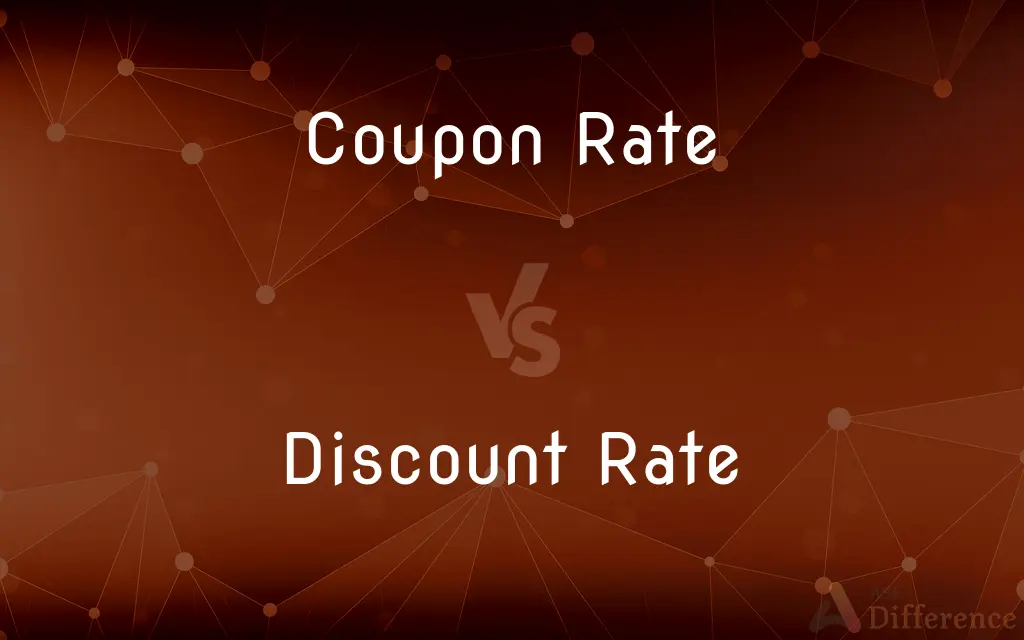Coupon Rate vs. Discount Rate — What's the Difference?
By Tayyaba Rehman — Published on October 25, 2023
Coupon Rate is the periodic interest percentage on a bond's face value, while Discount Rate is the interest rate used to determine the present value of future cash flows.

Difference Between Coupon Rate and Discount Rate
Table of Contents
ADVERTISEMENT
Key Differences
The Coupon Rate refers to the annual interest rate paid on a bond's face or par value. It's essentially the yield the bondholder receives as a return on their investment. Discount Rate, on the other hand, plays a crucial role in financial valuation and capital budgeting, helping to determine the present value of future cash flows.
Investors look at the Coupon Rate to understand how much they will earn from the bond over time. This rate remains fixed for fixed-rate bonds and doesn't change over the bond's life. In contrast, the Discount Rate adjusts the value of future benefits or obligations to reflect risk and the time value of money.
When an investor wants to determine the current worth of future returns on an investment, they'll employ the Discount Rate. However, when they want to know the fixed income from a bond, they'll consider the Coupon Rate.
Financial institutions, especially central banks, often use the Discount Rate as a tool to either stimulate economic growth or cool down an overheated economy. Meanwhile, the Coupon Rate remains a consistent metric of return for bondholders.
In essence, while both rates revolve around the concept of interest and returns, the Coupon Rate is more about guaranteed returns from bonds, and the Discount Rate deals with valuing future cash flows in today's terms.
ADVERTISEMENT
Comparison Chart
Definition
Annual interest rate on a bond's face value.
Rate used to determine the present value of future cash flows.
Application
Fixed income securities.
Financial valuation and capital budgeting.
Variability
Generally fixed for fixed-rate bonds.
Can vary based on risk and time preferences.
Purpose
To determine income from bonds.
To adjust future values to reflect current worth.
Influence
Determines bond yield.
Influences investment decisions and monetary policy.
Compare with Definitions
Coupon Rate
Annual interest rate of a bond's face value.
The bond has a Coupon Rate of 5%, meaning it pays $50 annually on a $1,000 bond.
Discount Rate
Reflects time value of money and risk.
The Discount Rate accounts for both inflation and investment risks.
Coupon Rate
Fixed percentage of return on bond's principal.
Despite market fluctuations, the Coupon Rate remains unchanged.
Discount Rate
Determines attractiveness of an investment.
A project with cash flows not justifying the Discount Rate may not be pursued.
Coupon Rate
Yield provided to bondholders.
Investors preferred the bond due to its high Coupon Rate.
Discount Rate
Rate central banks offer to depository institutions.
The central bank adjusted the Discount Rate to influence economic activities.
Coupon Rate
Periodic interest payment for bond investors.
The bond's Coupon Rate assures me of consistent income every year.
Discount Rate
Interest rate used in discounted cash flow analysis.
With a higher Discount Rate, the present value of the investment decreases.
Coupon Rate
Stated rate on bond certificates.
The bond certificate mentions a Coupon Rate of 4.5%.
Discount Rate
Tool to adjust future cash flows to current value.
Using an appropriate Discount Rate is crucial for accurate financial valuation.
Common Curiosities
What is the Coupon Rate?
The Coupon Rate is the annual interest percentage of a bond's face value.
How does the Discount Rate relate to future cash flows?
The Discount Rate helps determine the present value of future cash flows.
How is the Coupon Rate paid to bondholders?
Periodically, often semi-annually or annually, based on the bond's terms.
Does the Coupon Rate change for a fixed-rate bond?
No, the Coupon Rate remains fixed for the bond's life.
Why is the Discount Rate important in finance?
It adjusts the value of future cash flows, reflecting risk and time value of money.
What role do central banks play with the Discount Rate?
They might adjust it to influence monetary policy and economic activity.
Is the Coupon Rate the same for all bonds?
No, it varies based on bond issuer, maturity, market conditions, and other factors.
Can a bond have a zero Coupon Rate?
Yes, these are called zero-coupon bonds, sold at a discount and paying no periodic interest.
If a bond has a Coupon Rate of 5%, what does that mean?
It means the bond pays 5% of its face value as interest annually.
In what scenarios is the Discount Rate typically used?
It's used in capital budgeting, investment appraisal, and financial valuations.
Can the Discount Rate fluctuate?
Yes, it can vary based on economic conditions, perceived risks, and time preferences.
How does a high Discount Rate impact an investment's present value?
A higher Discount Rate reduces the present value of future cash flows.
What factors can influence the choice of Discount Rate?
Factors like inflation, risk, and time preference can influence the rate.
Can the Coupon Rate help in comparing bond returns?
Yes, it provides a fixed percentage return to compare across bonds.
How are Coupon Rate and yield to maturity different?
While Coupon Rate is the fixed interest rate on a bond's face value, yield to maturity considers the bond's purchase price, redemption value, time to maturity, and Coupon Rate.
Share Your Discovery

Previous Comparison
Dispositional Attribution vs. Situational Attribution
Next Comparison
Valency vs. Valence ElectronsAuthor Spotlight
Written by
Tayyaba RehmanTayyaba Rehman is a distinguished writer, currently serving as a primary contributor to askdifference.com. As a researcher in semantics and etymology, Tayyaba's passion for the complexity of languages and their distinctions has found a perfect home on the platform. Tayyaba delves into the intricacies of language, distinguishing between commonly confused words and phrases, thereby providing clarity for readers worldwide.











































